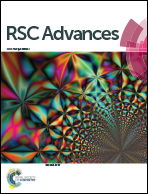Cross-linked silk sericin–gelatin 2D and 3D matrices for prospective tissue engineering applications†
Abstract
Biomaterials play an important role as templates to mimic native extracellular matrices in tissue engineering applications. Of late, attributes such as mitogenic activity, biocompatibility and biodegradability have conferred a special niche to silk sericin (SS) in the field of tissue engineering. This study deals with the fabrication of two dimensional (2D) and three dimensional (3D) matrices based on blending of gelatin with SS extracted from the cocoons of Bombyx mori (BM), Antheraea assamensis (AA) and Philosamia ricini (PR) silkworms. The fabricated matrices were cross-linked using 1-ethyl-3-(3-dimethylaminopropyl)carbodiimide (EDC)/N-hydroxysuccinimide (NHS). Assessment of surface topography using atomic force microscopy (AFM) revealed enhanced surface roughness of SS post blending with gelatin. The cross-linking mediated secondary structural changes were confirmed by Fourier transform infrared spectroscopy (FTIR). Gelatin/PR sericin (GPRS) blended 3D matrices were found to be highly porous compared to gelatin/BM sericin (GBMS), gelatin/AA sericin (GAAS) and only gelatin matrices. In vitro protein release studies showed maximum amount of SS release from GAAS matrices. Blending of SS with gelatin lowered the mechanical strength of the matrices. Cells (mouse fibroblast and human keratinocytes) cultured on gelatin/silk sericin (GSS) matrices showed enhanced attachment and proliferation. Furthermore, flow cytometric cell cycle analysis attested that the matrices supported cell growth without any cell cycle arrest. The amount of tumor necrosis factor (TNF)-α released by murine macrophage (Raw 264.7) cells cultured on GSS matrices suggested immunocompatibility of the fabricated matrices. These findings corroborate that the GSS 2D and 3D matrices may serve as prospective biomaterials in the domain of tissue engineering.


 Please wait while we load your content...
Please wait while we load your content...